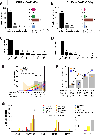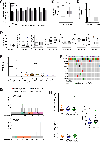Inflammatory cytokines promote clonal hematopoiesis with specific mutations in ulcerative colitis patients
- PMID: 31812712
- PMCID: PMC7031927
- DOI: 10.1016/j.exphem.2019.11.008
Inflammatory cytokines promote clonal hematopoiesis with specific mutations in ulcerative colitis patients
Abstract
Epidemiological sequencing studies have revealed that somatic mutations characteristic of myeloid neoplasms can be detected in the blood of asymptomatic individuals decades prior to presentation of any clinical symptoms. This premalignant condition is known as clonal hematopoiesis of indeterminate potential (CHIP). Despite the fact these mutant clones become readily detectable in the blood of elderly individuals (∼10% of people over the age of 65), the overall rate of disease progression remains relatively low. Thus, in addition to genetic mutations, there are likely environmental factors that contribute to clonal evolution in people with CHIP. One environmental stress that increases with age is inflammation. Although chronic inflammation is detrimental to the long-term function of normal hematopoietic stem cells, several recent studies in animal models have indicated hematopoietic stem cells with CHIP mutations may be resistant to these deleterious effects. However, direct evidence indicating a correlation between increased inflammation and accelerated CHIP in humans is currently lacking. In this study, we sequenced the peripheral blood cells of a cohort of patients with ulcerative colitis, an autoimmune disease characterized by increased levels of pro-inflammatory cytokines. This analysis revealed that the inflammatory environment of ulcerative colitis promoted CHIP with a distinct mutational spectrum, notably positive selection of clones with DNMT3A and PPM1D mutations. We also show a specific association between elevated levels of serum interferon gamma and DNMT3A mutations. These data add to our understanding of how cell extrinsic factors select for clones with specific mutations to promote clonal hematopoiesis.
Copyright © 2019 ISEH -- Society for Hematology and Stem Cells. Published by Elsevier Inc. All rights reserved.
Conflict of interest statement
DISCLOSURE OF CONFLICTS OF INTEREST
The authors declare no competing interests.
Figures


References
Publication types
MeSH terms
Substances
Grants and funding
LinkOut - more resources
Full Text Sources
Medical

